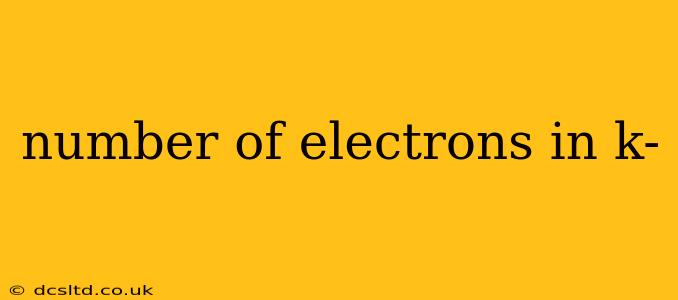The Number of Electrons in the K Shell: A Deep Dive into Atomic Structure
The K shell, also known as the first electron shell or energy level, plays a fundamental role in the structure of an atom. Understanding its electron capacity is crucial to grasping basic chemistry and physics. So, how many electrons can the K shell hold? The simple answer is two.
But let's delve deeper into the principles governing this limit. The number of electrons an atom's shell can hold isn't arbitrary; it's determined by fundamental quantum mechanical rules.
What Determines the Number of Electrons in the K Shell?
The maximum number of electrons a shell can hold is directly related to its principal quantum number (n). The K shell corresponds to n=1. The formula for calculating the maximum number of electrons in a shell is 2n², where 'n' is the principal quantum number. For the K shell (n=1), this translates to 2(1)² = 2 electrons.
This limitation arises from the Pauli Exclusion Principle, a cornerstone of quantum mechanics. This principle states that no two electrons in an atom can have the same set of four quantum numbers (principal quantum number, azimuthal quantum number, magnetic quantum number, and spin quantum number). The K shell, having only one subshell (the s subshell), can accommodate only two electrons, each with opposite spins (spin up and spin down).
Why is Understanding the K Shell Important?
Understanding the K shell's electron capacity is essential for several reasons:
-
Predicting Chemical Behavior: The number of electrons in the outermost shell (valence electrons) largely determines an element's chemical reactivity. While the K shell isn't the outermost shell for most atoms, it plays a critical role in determining the overall electron configuration, influencing an atom’s behavior. For elements like Helium (He), the K shell is the valence shell, and its full occupancy contributes to Helium's inert nature.
-
X-Ray Spectroscopy: The K shell is directly involved in the emission of characteristic X-rays. When an electron from a higher energy level transitions to fill a vacancy in the K shell, a characteristic X-ray is emitted, providing information about the atomic composition of a sample. The energy of these X-rays depends directly on the difference in energy between the K shell and higher energy levels.
-
Nuclear Physics: Understanding the K shell is crucial in nuclear physics and especially relevant when studying phenomena like K-capture, a type of radioactive decay where an inner shell electron (from the K shell) is captured by the nucleus.
What Happens if the K Shell is Not Full?
Atoms strive for stability, often achieved by having a complete outermost shell. However, the K shell's incomplete nature in most atoms doesn't necessarily make them inherently unstable. The stability of the atom is ultimately determined by the configuration of all electron shells, not just the K shell alone. However, atoms with an incomplete K shell are much more reactive and prone to forming chemical bonds to achieve a more stable electron configuration.
Does the number of electrons in the K shell vary between elements?
No, the K shell always holds a maximum of two electrons. The difference between elements arises from the number of electrons in higher energy levels (L, M, N, etc.). The number of protons in the nucleus (atomic number) determines the total number of electrons in a neutral atom, which then get filled into the electron shells according to the Aufbau principle and Hund's rule.
In summary, while seemingly simple, the K shell's electron capacity is a fundamental concept reflecting the underlying quantum mechanical principles governing atomic structure. Its importance extends across various scientific disciplines, highlighting its significance in understanding atomic behavior and interactions.
